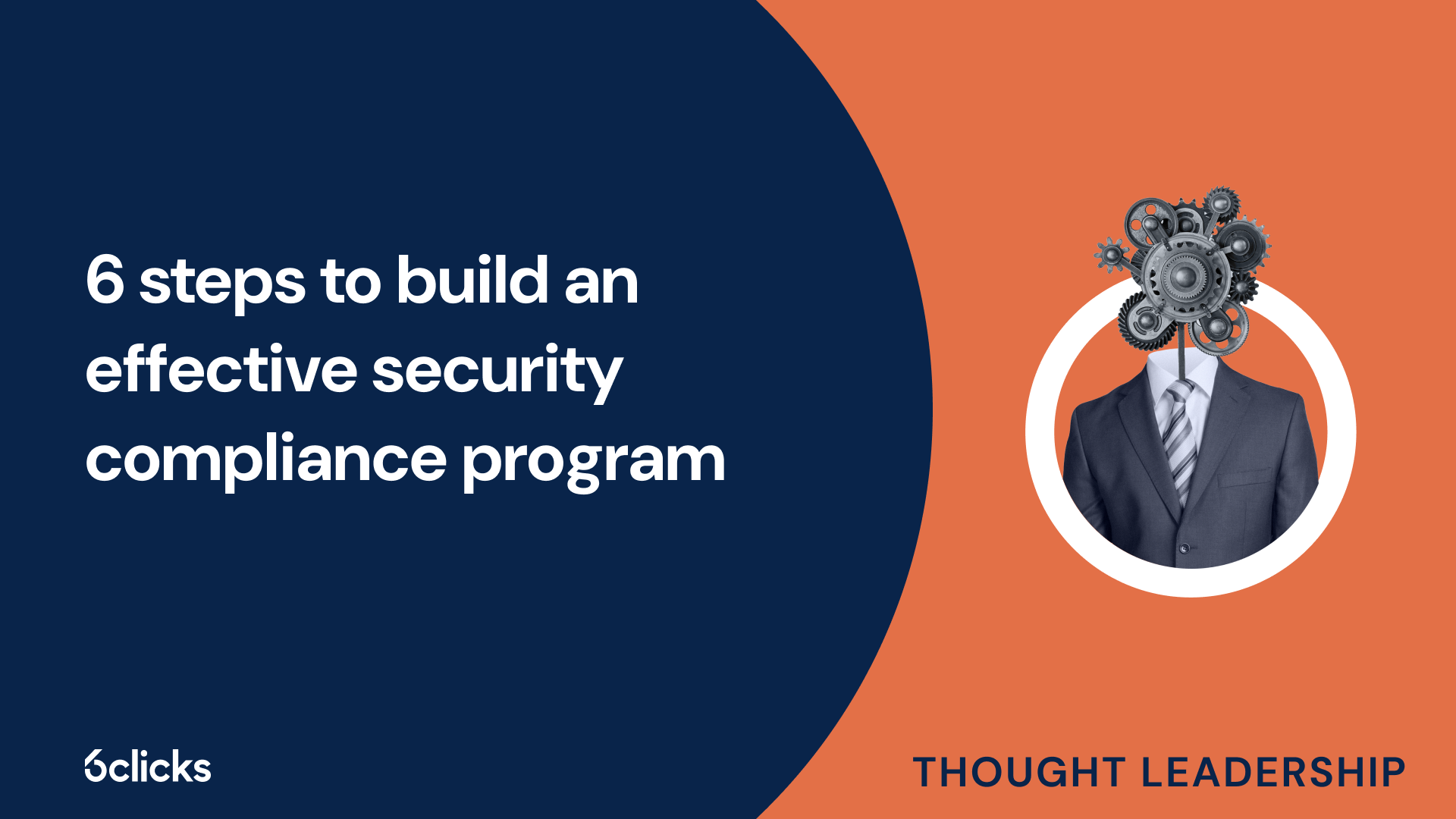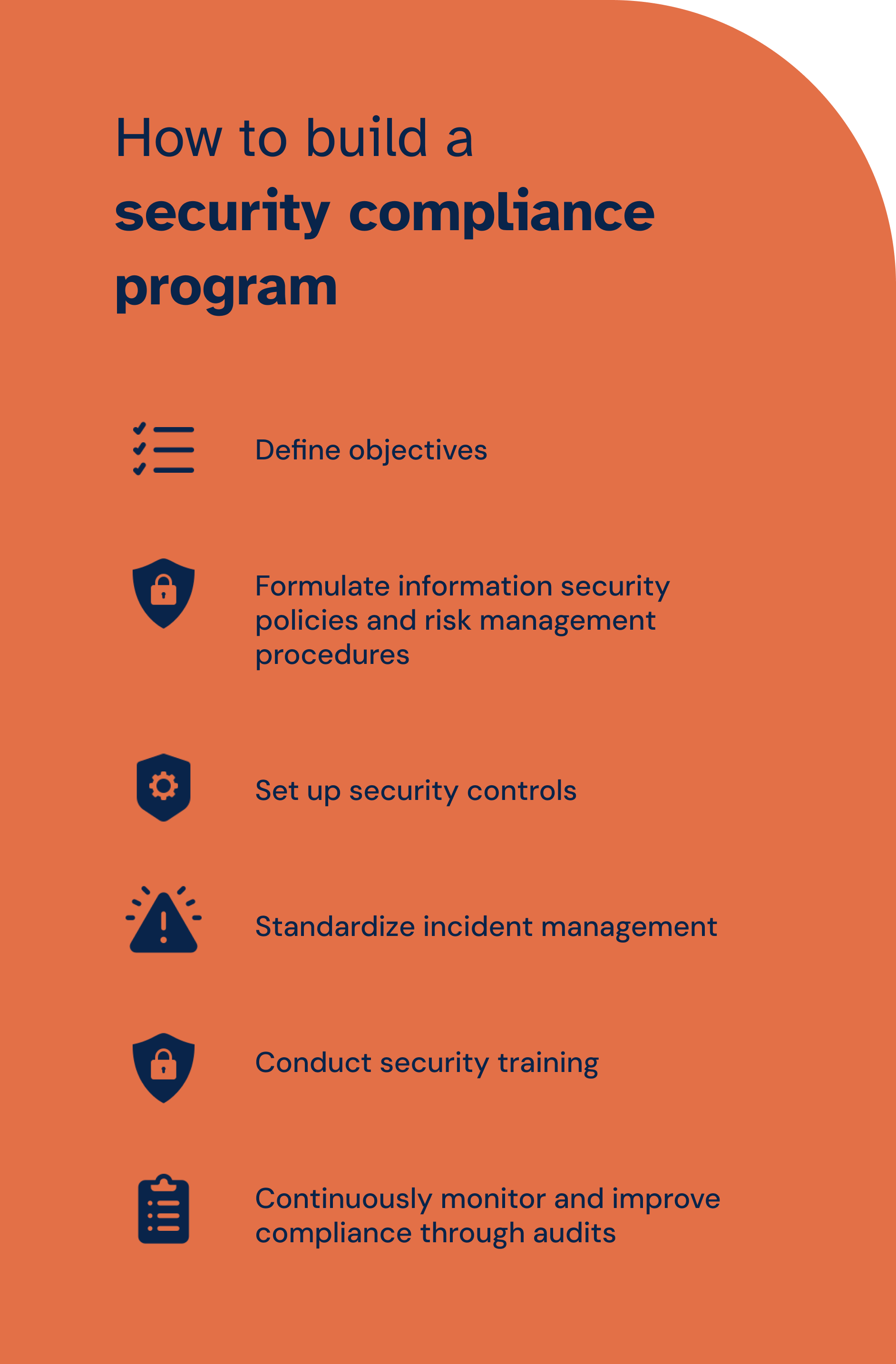
Today, organizations face increasingly advanced threats on top of evolving regulations and significant consequences of non-compliance. Thus, ensuring robust security compliance is no longer a necessity but a strategic imperative. An effective security compliance program not only offers a proactive approach to safeguarding your data and assets but also facilitates organizational growth. Let us walk you through the six essential steps to construct a comprehensive security compliance program that protects your organization from potential risks and aligns with legal requirements.
What is a security compliance program?
A security compliance program represents your organization’s strategy for meeting regulatory requirements, industry standards, and internal policies. It comprises a system of policies, procedures, controls, and tools for protecting your data, assets, and operations against various threats ranging from data breaches and cyberattacks to natural disasters and human errors. Security compliance empowers organizations to adopt a unified approach to:
- Risk management – The vast majority of regulations and compliance frameworks focuses on an organization’s capability to address risks, including cyber risks and third-party risks.
- Regulatory compliance – Ensure the legitimacy of your operations and increase your organization’s credibility by adhering to jurisdictional laws and industry requirements.
- Cybersecurity – Protecting an organization’s systems, networks, and technology infrastructure and upholding information security are some of the goals of security compliance.
- Operational resilience – Security compliance enables organizations to prevent and minimize security incidents and disruptions, improving business continuity.
- Building trust – Demonstrating your capacity for enhanced security and fulfilling stringent compliance requirements fosters stakeholder trust and gives your organization a competitive edge.
Components of security compliance
The process of security compliance is made up of the following components:

- Regulatory frameworks: An organization is subject to compliance with laws and regulations depending on their location, industry, data processing activities, and other aspects of their business. A security compliance program enables you to implement the specific requirements of regulatory frameworks such as:
- DORA – The Digital Operational Resilience Act applies to financial institutions within the European Union and mandates requirements for ICT risk management, third-party risk management, incident reporting, digital operational resilience testing, and information sharing.
- ISM – The Information Security Manual is a cybersecurity framework that outlines principles and guidelines that organizations must comply with to obtain certification and secure contracts with the Australian Government and Department of Defence.
- NIS 2 – The Network and Information Security Directive sets minimum security measures for entities located or operating within the EU under critical sectors such as transport, energy, and healthcare.
- CMMC – The Cybersecurity Maturity Model Certification framework provides five levels of maturity and specific controls that organizations handling classified and federal information must be certified in to be able to work with the US Department of Defense.
- Compliance standards: In addition to mandatory requirements, organizations must also align their security compliance strategy with industry best practices and voluntary compliance frameworks such as:
- ISO 27001 – Developed by the International Organization for Standardization, ISO 27001 is a globally recognized risk management framework that specifies requirements for building an information security management system (ISMS).
- NIST CSF – The National Institute of Standards and Technology’s Cybersecurity Framework provides organizations with guidelines and best practices for managing cybersecurity risks through 6 core functions: Govern, Identify, Protect, Detect, Respond, and Recover.
- SOC 2 – The Systems and Organization Controls Type 2 defines 5 trust services criteria for managing customer data, which include privacy, security, availability, confidentiality, and processing integrity.
- PCI DSS – The Payment Card Industry Data Security Standard details technical requirements for organizations and cloud service providers that process, store, or transmit cardholder data.
- Internal policies: Lastly, organizations are also governed by their own company policies and rules for prioritizing security. Some examples include data encryption, acceptable use, and remote work policies which organizations must enforce across their employees, vendors, and contractors to safeguard data and reduce risks.
How to build a security compliance program in 6 steps
Based on the components above, you can now build your security compliance program by following these basic steps:

Step 1: Define security compliance objectives
Start by defining the goals you want to achieve with your security compliance program. This involves identifying your assets, stakeholders, and operations and the corresponding compliance obligations that your organization must fulfill to safeguard them. From there, you can determine measurable, action-oriented objectives and key results (OKRs) that will then inform budgets, timelines, and resource allocation and serve as the foundations of your security compliance framework.
Step 2: Formulate policies and procedures
The next step is to draw up information security policies and risk management procedures, which include processes for risk assessment, risk treatment, and vendor risk management. These policies and procedures must align with the objectives you have set as well as with regulatory requirements and compliance frameworks applicable to your organization. Ensure that policies and procedures are well-written and documented as they detail the steps of your strategy and provide a basis for the roles and responsibilities of executives, employees, and vendors in achieving security compliance.
Using an integrated security compliance and IT risk management platform such as 6clicks, you can store compliance requirements, internal policies, and security controls all in one place and identify, assess, and mitigate risks in a single register, allowing you to easily manage and monitor your organization’s risk and compliance posture.
Step 3: Set up security controls
Once you have established your internal policies and procedures, it’s time to put security measures in place to prevent, detect, and minimize risks and incidents. Implement technical, operational, and administrative controls such as network segmentation, access control procedures, and data classification policies. Security controls must also be mapped to your compliance requirements to identify any compliance gaps. An AI-powered platform like 6clicks can automate compliance mapping and provide you with a comprehensive view of your compliance status.
Step 4: Create an incident response plan
Multiple regulations and compliance frameworks like DORA, NIS 2, ISO 27001, and NIST CSF include provisions for incident response plans. That said, part of your compliance obligations is implementing a system for identifying, investigating, and resolving issues and incidents and maintaining or restoring critical functions during disruptions. Establish procedures for incident reporting, mitigation, root cause analysis, and post-incident reviews to make way for proactive incident management.
Step 5: Conduct security training
With your objectives, policies, procedures, and controls already in place, the next step is communicating the details of your security compliance program to relevant stakeholders. This involves conducting security training and developing security awareness programs to educate employees, managers, and vendors on protocols and good cyber practices. By prioritizing security preparedness, you can cultivate a culture of risk management and compliance across your organization.
Step 6: Continuously monitor and improve compliance
Finally, security compliance is an iterative process that entails continuous review and enhancement. Performing regular security assessments and internal audits allows you to gather evidence of compliance and risk management activities, validate if security controls and risk mitigation measures are performing as intended, and track areas of non-compliance so you can implement corrective actions. By continuously monitoring and improving your security compliance program, you can verify the effectiveness of risk management strategies and maintain a consistent compliance posture.
Automate security compliance with 6clicks
Build a holistic security compliance program through the robust capabilities of 6clicks for security compliance, risk management, vendor risk management, incident management, and audits & assessments.
Simplify multi-framework compliance with ready-to-use control sets and assessment templates for DORA, ISO 27001, NIST CSF, SOC 2, and more.
Leverage the power of AI and automation in your security compliance strategy through our AI engine, Hailey, and continuous control monitoring feature. Hailey can instantly map your controls to any framework and generate policy descriptions and control definitions, streamlining time-consuming compliance tasks. Meanwhile, our continuous control monitoring solution enables you to automatically test the effectiveness of your controls and maintain ongoing compliance.
You can also utilize built-in risk and incident registers, incident reporting forms, task management functionalities, vendor assessment templates, and other integrated features from 6clicks.
See the 6clicks platform in action by booking a demo below.


